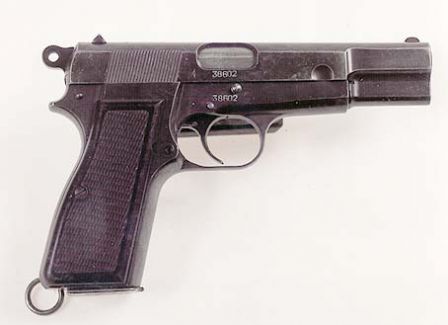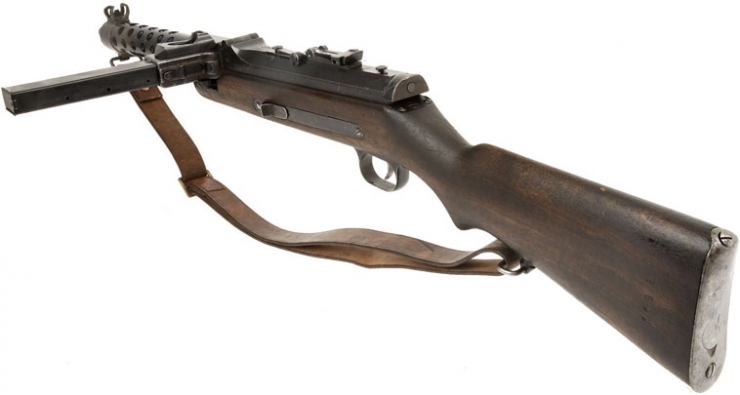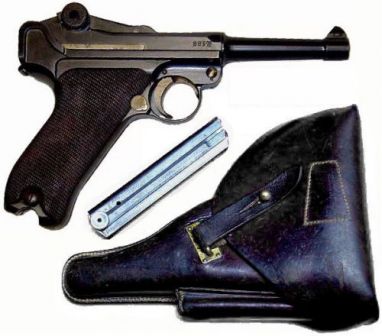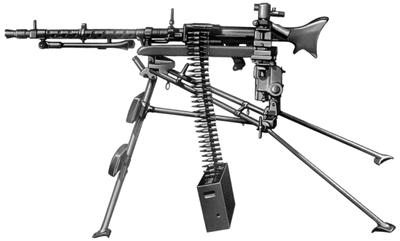Disclaimer: It is not always possible to check copyrights on pictures. I will remove them in case of unauthorised use.
For more detailed information, much can be found here: http://world.guns.ru/
Many orginal pictures are available here: http://18daagseveldtocht.wikispaces.com/
This time, I will write about the standard infantry weapons of Belgium and Germany in 1940. Both Belgium and Germany expanded their armed forces in 1930's. Weapon production had trouble keeping up so both sides used older weapons next to newer ones.
Belgium
Handguns
The standard Belgian handgun was the FN Browning Grand Puissance (High Power) in 9mm Parabellum (9x19). It had a magazine capacity of 13 rounds. A lot more than the 8 rounds of the Luger or the 6 rounds in the British Webley and Enfield revolvers. It was a reliable weapon. The Germans restarted production in occupied Belgium for their own use. The Browning HP was also used by the Western Allies.This weapon was the standard armament of officers in combat units and crews who operated heavy machineguns, mortars or anti-tankguns.

Some older FN Browning handguns were also in use like the model 1903, 1910 and 1922. Most of these used 7.65x17mm Browning ammunition. These older weapons were issued to rear-echelon units.
Submachine guns
The standard submachine gun was the Mitraillette Modèle 1934. This weapon was a licence produced version of the German MP28/II. The submachine guns were produced by the Belgian company Societe Anonyme Anciens Establissments Pieper Bayard. The smg was fed by box magazines holding 32 rounds of 9mm Parabellum. It was a very good and reliable weapon, but a bit expensive to produce. Captured weapons seemed to have been used by the Germans.Two assistants of the commander of an infantry company were armed with a Mitraillette 34. Eight men in the regimental reconnaissance platoon were also armed with this weapon. Active and first reserve divisions had about 80 MP34's total. The Chasseurs Ardennais also received a large amount of Mitraillette 34's, about 216.


Rifles
The standard rifles in use in 1940 were the FN Modèle 1935 and Modèle 1936. Both were based on the Mauser design. The Modèle 1935 was produced by FN and M.A.E. (Manufature d'Armes de l'Etat). These rifles were manufactured from completely new parts. Because of the rapid expansion of the Belgian army a second weapon was produced, the Modèle 1936.The Modèle 1936 made use of the stock of old Mauser Modèle 1889 rifles. Some parts of the old weapons were reused but they received a new barrel, sights, hand-shield, recoil spacer , barrel bands, bayonet stud, front sight with ears are those of the MOD. 35. This made them nearly identical to the Modèle 1935 but a bit cheaper to make. The Modèle 1936 was produced by M.A.E. and Pieper.

Divisions of second reserve and rear-echelon units used the original Mauser Modèle 1889. These weapons were worn out from use in the First World War. All three rifles used the standard 7,65 X 54 mm ammunition. The Belgian 7,65x54 mm ammunition was an effective round and it was used by all Belgian rifles and machineguns.
The Belgian FN Mauser designs have much in common with the standard German Mauser Karabiner 98k and other bolt-action rifles. Bolt-action rifles formed the main armament of infantrymen during WW1 and WW2. These rifles generally had a calibre between 7.5 and 7.92mm and held about five rounds. Some countries, like Italy, the Netherlands and Japan used 6.5mm ammunition. A common complaint about these lighter 6.5mm rounds was that the bullets did not inflict enough damage to take out an enemy with one shot. These armies also used a different bigger calibre for their heavy machineguns. This complicated logistics.
This site contains more info and pictures.
http://www.littlegun.be/arme%20belge/fusils%20reglementaires/1%201%20armes%20reglementaires%20gb.htm
Light machineguns
The standard light machinegun in Belgian service was the Fusil-mitrailleur modèle 1930, FM30. This was a Belgian version of the Browning Automatic Rifle. The Belgian design had a pistol grip and fired the standard Belgian 7.65x54mm from a 20-round magazine. The weapons had a handle on top. The FM30 Model D had a quick-change barrel. The weapon was usually fired from its bipod. A light tripod for ground and anti-aircraft fire was also in use. This weapon equipped all infantry divisions of active and 1st reserve, as well as the cavalry and the Chasseurs Ardennais. Each Belgian infantry platoon had four LMG's.


The weapon weighed 9 kg, a bit more than the US BAR. It had a fire-selector with two options. The first option was a reduced rate-of-fire of 350 rounds per minute. The second option was 600 rpm.
The option for a reduced rate-of-fire allowed the gunner to conserve ammunition when rapid fire was not required. This option was used most frequently in combat. The high ROF was recommended in crisis moments when assaulted by enemies. The F.M.30 was a reliable and accurate weapon. Its main drawback was the rather small 20 round magazine. The F.M.30 had a good front grip. This meant that the MG could be fired from the hip if necessary.
Most light machineguns in 1940 used magazines. Magazines were positioned underneath the gun, on top or from the side. Feeding the gun from below allowed for a good vision and a balanced weight but restricted the size of the magazine. Magazines on top could carry about 30 rounds and provided a balanced weigth but blocked the vision. Magazines on the side unbalanced the gun. The German MG34 was fed by a 50 round drum magazine or by belts. Belts had a much larger capacity of up to 250 rounds. However the operators needed to make sure that the belt did not get stuck. The assistant gunner was responsable for this task. The MG34 weighed 12kg, more than most other light machineguns.
Belgian infantry divisions of 2nd reserve were equipped with the older Chauchat light machinegun. This weapon had been used by the Belgians in WW1. All LMG's fired the standard 7,65 X 54 mm ammunition from a 20-round magazine. This fully enclosed magazine was a good improvement over the original open magazine. Still, these weapons were quite old and worn out.

Heavy machineguns
Active and 1st reserve infantry divisions used the Maxim MG08 heavy machinegun on its typical sled mount. Again, all HMG's used the standard 7,65 X 54 mm ammunition. Belgium bought several of these weapons prior to WW1 and received many ex-German wepaons. It was a heavy weapon but it could put out a lot of fire.
The Chasseurs Ardennais and the motorised cavalry used the French Hotchkiss Modèle 1914. The Hotchkiss weighed about 25kg, a lot less than the MG08 with 65kg. This lighter weight made it well suited for the mobile Chasseurs Ardennais and cavalry.

As always the divisions of 2nd reserve had to make do with older weapons, the M1895 Colt–Browning machine gun. It had a relatively low firing rate: 400-450 rpm versus 500-600 of the MG08.

Light mortar
The final Belgian piece of equipment that I want to talk about is the DBT lance-grenades (light mortar). Every infantry platoon in active and first reserve divisions had three of these. German and British platoons only had one light mortar per platoon.This light mortar fired 50mm grenades with a weight of 600 grammes and had a maximum range of 600 meter. Both HE and smoke rounds were available.
More info at:
http://www.littlegun.be/arme%20belge/fusils%20reglementaires/1%201934%20dbt%20fr.htm
Grenades
The Belgian Army had two kinds of grenades. Offensive O.F. grenades with a smaller fragmentation effect and defensive Mills grenades with a much larger fragmentation effect. The 6 men of the F.G group carried 3 grenades each.
Germany
Handguns
The most common German handgun was the Luger in 9mm Parabellum. The army also made use of the Walther P38. The Walther and Luger held 8 rounds in a magazine. Later in the war, Germany made made extensive use of the Belgian FN Browning High Power.

Submachine guns
Many photo's of German soldiers show them armed with submachine guns. In reality, the large majority of all soldiers were armed with bolt-action rifles. MP's were often given to NCO's. They had a rather short range, but the high rate of fire made them excellent at close quarters combat. The Germans started the war with the MP18 from WW1 and the improved MP28/II. These were good weapons but rather expensive to make. The MP38 and MP40 were cheaper weapons with similar performances. All these weapons fired the 9mm Parabellum. German divisions of the 1ste Welle had 312 submachineguns. Divisions of other recruitment waves had less of them. Later in the war, the Germans would often use Soviet PPSh41's on the Eastern Front or Italian Beretta's in Italy to increase their access to MP's.
German soldiers in Norway with a MP28.
Rifles
The standard German rifle during WW2 was the Mauser Kar98k. This was a shortened version of the Mauser Gewehr 98 from WW1. The Kar98k was a standard bolt-action rifle with an internal magazine of 5 rounds. The Kar98k fired the standard German 7.92x57mm Mauser ammo.

Germany also used captured Polish and Czech rifles.
Light machineguns
The standard German LMG was the MG34. The MG34 was a belt-fed general-purpose machinegun that could serve as a LMG with a bipod or as a heavy machinegun with tripod. The weapon could be loaded with a 50 round drum magazine or with belts. This MG had a maximum rate-of-fire of 900 RPM. It had a quick-change barrel for cooling. The MG34 was a versatile weapon. It could put down a lot of fire if plenty of ammunition was available. This was often the case on the defense, when ammunition could be stored in the trenches.
On the attack, soldiers would have to make do with what they could carry or bring forward. The standard ammunition load for a German squad was 1150 rounds. Note that the standard load for a Belgian squad was 1120 rounds. To save ammo, MG34-gunners had to shoot short aimed bursts of fire.

The Germans were short on MG34's in 1940. The armed forces had expandede rapidly and the MG34 had to serve both as LMG and HMG. This meant that other weapons were also used in 1940. Many infantry divisions used the MG13. This weapon had been adopted in the early 1930's. It was air-cooled weapon that was loaded with 25 round magazines from the side.

A third weapon that was used in 1940 was the MG 26(t). These were ZB 26 LMG's captured from the Czechs. This weapon was especially used by the Waffen SS divisions in 1940. It was fed by a 20 round magazine from the top.


Heavy machineguns
As written above, Germany also used the MG34 as a heavy machinegun. The MG34 was a versatile weapon. German units had the option to fire the MG34 as a HMG with tripod or they could dismount their weapons and attack as regular infantry. This gave them a lot of flexibility.
In 1940, many HMG units in German infantry divisions were equipped with the old watercooled Maxim MG08 due to the short supply of new weapons. The MG08 is the same weapon as the Belgians used but it fired the German 7.92x57mm Mauser ammo.


In 1940, many HMG units in German infantry divisions were equipped with the old watercooled Maxim MG08 due to the short supply of new weapons. The MG08 is the same weapon as the Belgians used but it fired the German 7.92x57mm Mauser ammo.


Light mortar
The standard German light mortar was the 5cm Granatwerfer 36. Every German platoon had one of these. It had a range of 520 meters.

Flamethrower
German assault pioneer units had a special but devastating weapon: the Flammenwerfer 35. It had a rang of about 25 meters and weighed 35.8 kg. They used it to attack bunkers and fortifications.
Grenades
The Germans used several grenades. The Model 24 grenade Stielhandgranate is the most famous. The Model 39 Eihandgranate is another popular grenade.
Conclusion
There is not a lot of difference between German and Belgian infantry weapons. The Belgian army used several weapons of German design like the Mauser rifles, Mitraillette 34 and Maxim MG08. On the other hand, Germay would use several captured weapons after the armistice, especially the FN Browning High Power.The MG34 is the most noteworthy German weapon. Its high ROF made it a very potent weapon. The first burst of fire on inattentive enemies could do a lot of damage before they could take cover.But as I said, other LMG's were used in 1940 to fill in shortages. The German infantry squad did not carry more ammo on the attack than the Belgians. It was mostly later in the war when the Germans were on the defence that the true firepower of the MG34 and MG42 mattered. The Germans, short on manpower, began to rely more and more on the firepower of the MG34 and MG42. The tasks of the German riflemen in the infantry squad became protecting the MG and carrying ammo. However on the attack, the poor bloody infantry still had to assault and clear positions.
The best German infantry divisions had a significant amount of submachineguns. But most soldiers were still armed with the simple but reliable Mauser K98k. Belgian divisions had less SMG's, but still had a decent amount of them. British and French divisions actually didn't have any submachineguns in use yet in 1940. The French MAS-38 was only taken in production around the time of the German invasion. The British did not have much interest until after the fall of France. They used American Thompsons at first and produced the Sten later during WW2.
.

